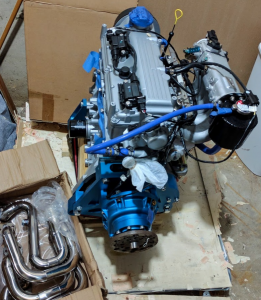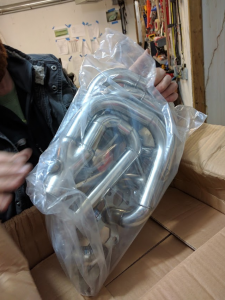Today we drove over to a local loading dock where we had arranged for the crate containing our new Aeromomentum AM15 engine to be delivered.
Then we drove it over to my garage and opened the crate.
We’re excited about doing some pioneer work with the engine.
It is based on a Suzuki G15A 115HP SOHC engine that is still a high volume engine in Asia.
We purchased the upright model for $9995 with silver/blue colors.
We came close to purchasing a ULPower engine. We spent several hours with each vendor at Oshkosh.
We really like Mark from Aeromomentum and the price is attractive.
He’s sold 100+ engines, has 3 Aventuras flying and a bunch of airboat users.
I believe we are the second Searey purchaser.
They provide a mount that will attach directly to the 914 root tube.
We spent a long time looking at the Viking/Honda engines. Jan was good about providing information and I like his enthusiasm for trying new things with the Searey. I respect all these guys for innovating and trying to make aviation engines more affordable.
Weight Info:
Slant engine dry, with all reservoirs, no radiator, sensors but no wiring harness – weighs 171.5 lbs
Our upright engine will be several pounds lighter than the slant, especially when installed on a root tube.
Harness is 2 lbs. ECU is 12 oz, big radiator: 4.8 lbs
That comes to 180ish dry all inclusive +1 gal of coolant, 1 gal of oil
Fully installed: The AM15 should be 20-25 lbs heavier than the lightest 912 and ~15 lbs heavier than a 914.We believe that the The Suzuki block is 36.5 lbs lighter than a Honda Fit engine before any conversion.
However, the AM15 is really only about 30lbs lighter than the Viking 130 because Honda uses lighter-weight standard components such as a plastic manifold and exhaust manifold cast into the head where the Suzuki has a header
Why did we choose the upright engine if we think the slant engine looks better?
1. Weighs less and costs less.
2. Aeromomentum is interested in helping us build a cowl for the upright engine because they can use it
for other applications. They are not as interested in doing that for the slant engine.
3. The upright is more suitable for later installation of a turbo.
The output shaft power at max RPM is
117hp@5800 shaft rpm.
Prop RPM is 2240 and reduction ratio is 2.59.
Positive is that it turns the prop slowly, which will hopefully make it quieter.
For aviation we think a simpler/lighter engine is better. For example Suzuki later redesigned our engine to have a four-valve head – the new engine is the M15 (instead of our G15). The M15 is heavier but is not really more powerful. The improvements were all in emissions, torque curve, and light-load efficiency (with VVT) – and thus add weight and cost and complexity without major advantages for aviation, where we will run at fairly constant speeds.





